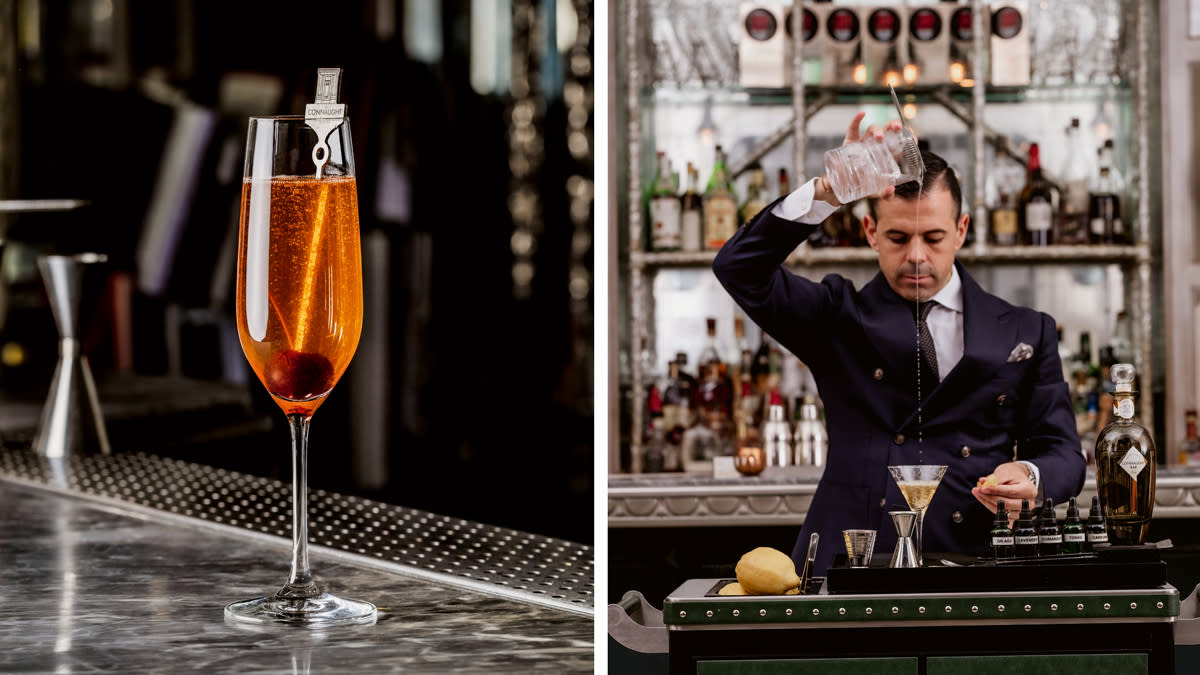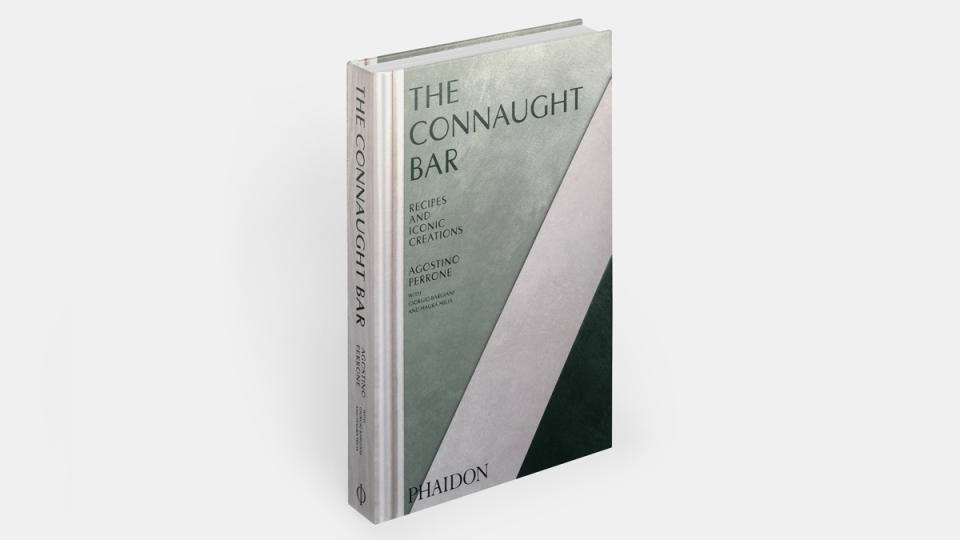How to Make a Betty Is Back, a Delicious Spritz From London’s Famed Connaught Bar

On one hand, the idea of the “best bar in the world” doesn’t make any sense. What kind of bar, and according to whom? Bars are too many things to too many people—exciting, relaxing, comforting, adventurous, and so much more. It’s a little like asking after the “best music.” It’s an idea too broad to be comprehensible.
On the other hand, you could treat this question as if it had an answer. You could tally up all the awards and accolades for cocktails and decor and service a bar can receive, as well as consider industry reputation, consistency, and professionalism, and if you do all that, the “best bar in the world” is not only comprehensible, there is a clear answer. It’s the Connaught Bar.
More from Robb Report
Chris Pratt and Katherine Schwarzenegger Just Tore Down This Stunning Midcentury Modern Home
A Former Apple CEO's Onetime Northern California Estate Hits the Market for $23 Million
George Clooney and Cindy Crawford Just Dropped Casamigas, a Jalepeño-Infused Tequila
No bar in modern history, anywhere in the world, has had a run like the Connaught Bar. Since it opened in 2008 in Mayfair, in Central London, the bar and head barman Agostino Perrone have not only won every award there is to win, but they have won them over and over again. At the annual Tales of the Cocktail in New Orleans, the Connaught Bar won World’s Best Hotel Bar in 2010, and then World’s Best Cocktail Bar in 2012, and then both of them again in 2016. It’s also enjoyed top marks from every travel magazine that considers such things. Another data point: Not only did the Connaught win Best Bar in the World by the 50 Best Bars organization in both 2020 and 2021, but since the list was started in 2009, they’ve appeared a record 14 times, and their average placement on the list is another record, at number 5. No other venue even comes close.
So it was with excitement that cocktail aficionados learned that Perrone and company would be coming out with the Connaught Bar Book, to be released by Phaidon Press on April 10. In it, after a brief discussion of philosophy and technique, Perrone details about a hundred Connaught Bar originals, with instructions to make them at home.
The list is a fascinating set, as much as anything because it traces the evolution of London’s cocktail scene, from 2008 to the present day. Anyone familiar with the upper reaches of the 50 Best Bar list has come to expect baroque recipes and obscure ingredients, and if you’re looking for this kind of thing (e.g. korerima pod-infused mastiha, a clementine and tonka bean shrub, “elicriso essence,” etc., etc.), the book doesn’t disappoint. In a single cocktail, the Give it the Green Light, they recruit a passion-berry- and grapeseed-oil-washed vodka, tomato-skin-infused gin, osmanthus and timur pepper syrup, something they call “electric bitters,” and, as a garnish, fresh sorrel leaves. It’s a lot.
But there are also a few old favorites from the early days of the bar, kept alive by sheer tastiness and grandfathered into the book by popularity and tradition. Of those, the simplest and most viscerally delicious I’ve yet tried is the Betty is Back, “the very first drink to appear on the refurbished Connaught Bar’s opening menu,” Perrone writes, and a tribute to the head bartender in the 1940s—Aperol, St. Germain, lemon juice, and Champagne. Bartenders the world over have futzed about with this set of ingredients, but it’s never been cleaner and more precise as this, with perfect balance and clarity. It doesn’t read like a Connaught Bar drink (there’s no wattleseed infusion, for instance) but it feels like one, demonstrating a restraint and elegance rarely deployed in the spritz category. It’s a lovely and thoroughly delicious time capsule, the liquid beginnings of what could, for argument’s sake, be called the best bar in the world.
Betty Is Back
Reproduced from the Connaught Bar Book
15ml (0.5 oz) Aperol
5ml (1 tsp) St. Germain
5ml (1 tsp) lemon juice
100ml (3.5 oz) Champagne
Add all ingredients except Champagne to a mixing glass with ice, and stir briefly to chill, about 10-15 seconds. Strain off the ice into a chilled coupe or flute, and top, gently, with sparkling wine. Garnish with a cocktail cherry, on a pick.
NOTES ON INGREDIENTS:
Aperol: Aperol is distinct and delicious, in addition to being ubiquitous and inexpensive, and I don’t see much of a reason not to insist on it. That said, what the Aperol is doing here is adding a very slight bitterness and some juicy herbal orange notes to the final product, so if you didn’t have Aperol but had, say, Select Aperitivo, or Cappelletti, or the Sirene Vino Amaro, I’d still make this and enjoy it.
St. Germain: St. Germain is a little more specific. There are other elderflower liqueurs, but this is used in such small amounts, I wonder if this variable is as flexible as the Aperol. In the Betty is Back, this little teaspoon of St. Germain gives an ever-so-gentle fleshiness to the orange fruit, with a floral boost. You can try it with a different elderflower liqueur if you have a mind to, and I’m sure it would be good. But with the exact fingerprint of St. Germain, it’s great, and I’m not sure how replaceable that is.
Sparkling Wine: The Connaught Bar makes this with Champagne. Honestly, just the sight of the Connaught Bar feels like drinking Champagne. That said, while real, actual, French Champagne is the best way to bring your French 75 or Old Cuban to otherwise untouchable heights, here, I actually preferred Cava, the Spanish traditional method sparkling wine. It’s still amazing with Champagne, but Champagne’s deep and dynamic finish—the unmatched complexity that comes from many months of sitting on the lees and the precise reason Champagne is so expensive—can be too much here. The Aperol and the St. Germain play off each other in a really lovely way on the finish, and the bold lingering complexity of Champagne distracts a bit from that show, too many voices at once. Again, it’s totally delicious either way, but if I could choose, I’d either do as basic a Champagne as I could find or otherwise a nice bottle of Cava or Cremant, which will run something like $20.
Garnish: The Connaught garnishes with a cocktail cherry, which doesn’t really do anything for the drink but it does look nice. That said, it will cause the cocktail to lose bubbles faster than it would otherwise, and if it’s not refrigerated, it’ll warm it up, so feel free to skip the garnish if you don’t want either of those outcomes.
Quantities: The official recipe from the Connaught Bar (seen above) makes a respectable and demure 4.5 oz cocktail or so, which is fairly small by our tastes. I wouldn’t just add more Champagne—the balance is utterly perfect, don’t mess with it—so my instinct is to increase all measures by 50 percent (which would be 0.25 oz lemon juice, 0.25 oz St. Germain, 0.75 oz Aperol, and about 5.25 oz sparkling wine). Call me garish and American if you like. The shoe fits.
Best of Robb Report
Why a Heritage Turkey Is the Best Thanksgiving Bird—and How to Get One
The 10 Best Wines to Pair With Steak, From Cabernet to Malbec
Sign up for Robb Report's Newsletter. For the latest news, follow us on Facebook, Twitter, and Instagram.


